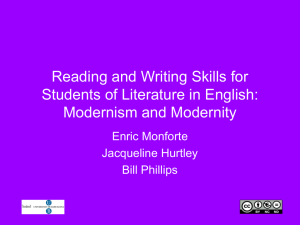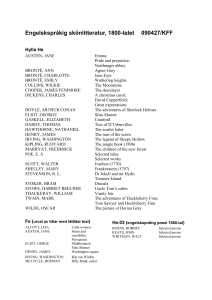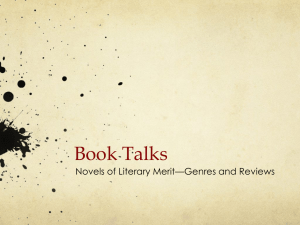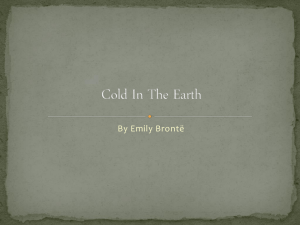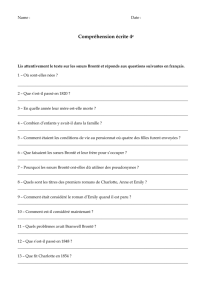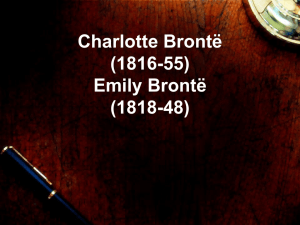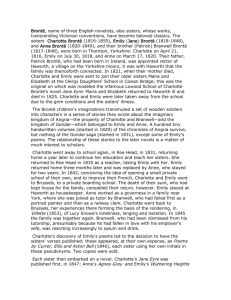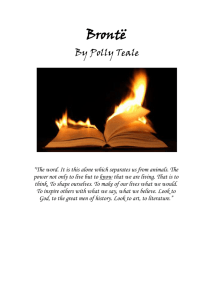Emily Brontë - Broadview Press
advertisement
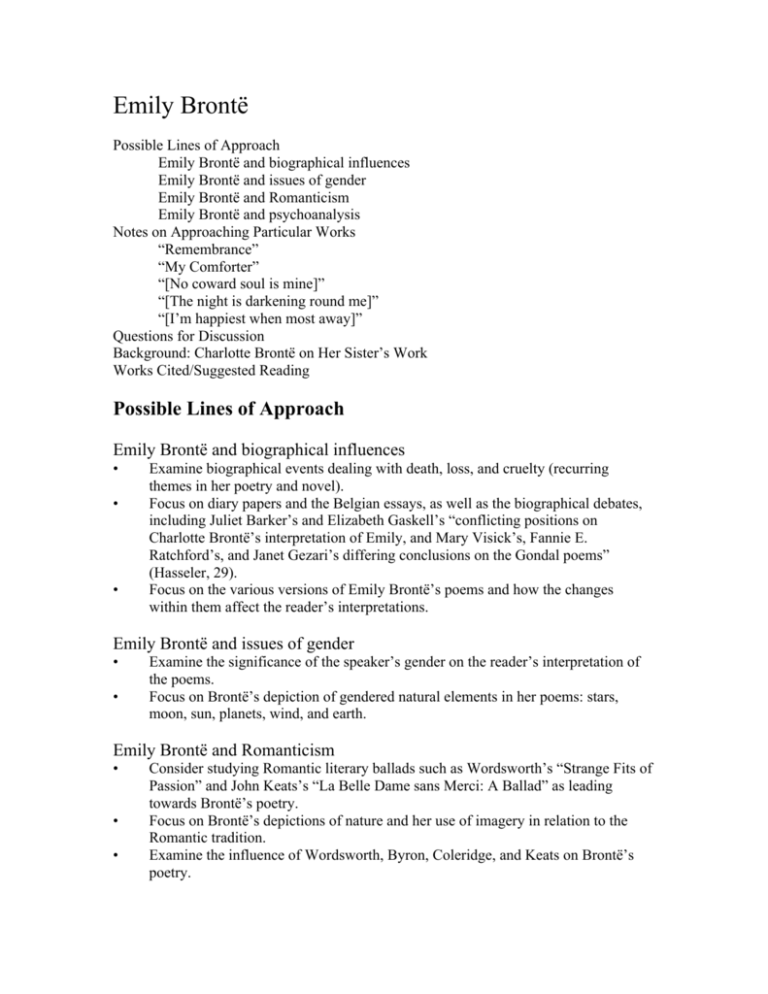
Emily Brontë Possible Lines of Approach Emily Brontë and biographical influences Emily Brontë and issues of gender Emily Brontë and Romanticism Emily Brontë and psychoanalysis Notes on Approaching Particular Works “Remembrance” “My Comforter” “[No coward soul is mine]” “[The night is darkening round me]” “[I’m happiest when most away]” Questions for Discussion Background: Charlotte Brontë on Her Sister’s Work Works Cited/Suggested Reading Possible Lines of Approach Emily Brontë and biographical influences • • • Examine biographical events dealing with death, loss, and cruelty (recurring themes in her poetry and novel). Focus on diary papers and the Belgian essays, as well as the biographical debates, including Juliet Barker’s and Elizabeth Gaskell’s “conflicting positions on Charlotte Brontë’s interpretation of Emily, and Mary Visick’s, Fannie E. Ratchford’s, and Janet Gezari’s differing conclusions on the Gondal poems” (Hasseler, 29). Focus on the various versions of Emily Brontë’s poems and how the changes within them affect the reader’s interpretations. Emily Brontë and issues of gender • • Examine the significance of the speaker’s gender on the reader’s interpretation of the poems. Focus on Brontë’s depiction of gendered natural elements in her poems: stars, moon, sun, planets, wind, and earth. Emily Brontë and Romanticism • • • Consider studying Romantic literary ballads such as Wordsworth’s “Strange Fits of Passion” and John Keats’s “La Belle Dame sans Merci: A Ballad” as leading towards Brontë’s poetry. Focus on Brontë’s depictions of nature and her use of imagery in relation to the Romantic tradition. Examine the influence of Wordsworth, Byron, Coleridge, and Keats on Brontë’s poetry. Emily Brontë and psychoanalysis • Focusing on Brontë’s poems that explore memory and loss, examine how Brontë anticipates Freud. Refer to Freud’s “Notes upon a Case of Obsessional Neurosis” to explore the threat memory poses and John Addington Symonds’ Sleep and Dreams (1851). (For more on this approach see Gezari, 42). Notes on Approaching Particular Works “Remembrance” Form: Lyric poem/elegy/arguably a dramatic monologue. The poem is in 8 stanzas, each of 4 lines, with each line having 5 stressed syllables and a variable number of unstressed syllables. Background/Approaches The Gondal narrative context: In discussing this poem, it is probably helpful to fill in some background for the student regarding the Brontës’ Gondal narrative—though there may be a good case to be made for filling in this background after, rather than before, an initial discussion of the poem with students (and exploration of the narrator’s voice). The Gondal narrative is touched on briefly in the Broadview Anthology’s introduction to Brontë. Here is a brief summary of the Gondal adventures created by Emily and Anne: We are to think of a mythical island in the North Pacific, divided into several hostile kingdoms. Julius Brenzaida, Prince of Angora in Northern Gondal, is loved by Rosina, Princess of Alcona in the south. He conquers the kingdom of Almedore and sacks the city of Zalona. Then he secretly marries Geraldine Sidonia, daughter of a conquered family. Soon, however, he leaves her, possibly to return to Rosina. Geraldine has a child, Augusta Geraldine Almeda, and she decides to bring the infant to Julius. But on the voyage the ship is wrecked, and Geraldine is drowned. The child is saved and brought to Julius, who arranges to have her reared in the mountains of Angora. Julius then marries Rosina. A child is born to them, a beautiful boy. Julius captures the city of Tyndarum. Shortly after, he betrays Gerald of Exina, and casts him into prison along with Gerald’s son Arthur. But a rebellion is raised against Julius, and he is murdered. (Donoghue, 78) A number of Emily Brontë’s later poems develop out of the Gondal narrative (and are sometimes referred to as the “Gondal poems”; of these the best known is “Remembrance,” the original manuscript of which alluded directly to the Gondal narrative through the inclusion of the words “R. Alcona to J. Brenzaida” in the title. Is our response to the poem subtly colored by whether we read it as a direct outpouring of feeling from the poet or as flowing out of an imagined world? In the mid-twentieth century a frequent reference point for such discussions was F.R. Leavis’s “Reality and Sincerity,” which alleges that the poem suffers for its “insincerity” of feeling. (A more recent reference point for discussions of sincerity and authenticity in the context of Victorian poetry by women is Angela Leighton’s Writing Against the Heart—though Leighton does not discuss this poem directly in that book.) To what extent is it appropriate to see the poem as functioning as a dramatic monologue? Memory and Loss: The poem’s theme of loss and the desperate need for remembrance responds to the nineteenth century’s obsession over tokens and keepsakes to aid in keeping one’s memory alive. (See the volume introduction of the Broadview Anthology for more on this.) Other nineteenth-century poets who published poems with the title “remembrance” include Byron, Percy Shelley, L.E.L., and Southey. Janet Gezari suggests that remembrance may be contrasted with recollection in that “remembrance is involuntary and gives present life to what once lived and has only seemed dead” (25). In Gezari’s view, Brontë is very much a poet of remembrance: “in all of Brontë’s poems, the boundary between the past and present is permeable and always in danger of collapsing entirely” (25). Gezari recognizes how Brontë anticipates Freud by “recognizing that there is no cure for memory” (41). She cites Freud’s “Notes upon a Case of Obsessional Neurosis” as exploring the threat that memory poses (Gezari, 42). On the same subject, Gezari refers to John Addington Symonds’ Sleep and Dreams, which distinguishes between passive and active memories (42). In Gezari’s view, the poem illustrates how “Brontë’s protest against death requires the survival of remembrance… ‘Remembrance’ turns on the axis of this dense psychological contradiction” (41). Steve Vine, on the other hand, comments on how the poem “sustains the symbolic distances of elegy, the fusion of its speaker with the entombed object of desire radically suspends the work of mourning and plunges the self toward death. The collapse of mourning resurrects the ghost of lost love” (124). Angela Leighton, for her part, notes that the first lines of this poem “insist on memory, even while admitting forgetfulness. The repetitions, of cold, far, love, and sever, convey a haunting not of ghosts, but of language” (Leighton, “The Poetry,” 62). The elements: Gazari points out that the poem “invokes three of the four elements in its first two stanzas—earth, water (in two forms), and air … the fourth element, fire, figures explicitly only in the second half of the poem, in words like ‘light’, ‘morn’, and ‘burning’” (50). In addition to natural elements, Brontë uses the “elemental opposition of heat and cold in the poem … to relate to another opposition that shapes the speaker’s understanding of her difference from her buried lover and marks her acknowledgement of his death” (51). As she does in various other poems, Brontë here, in Gezari’s view, represents “the living as struggling against their confinement in the world and the flesh, while the dead have won release” (51). Poetic Techniques: Janet Gezari argues that “the refusal of termination in ‘Remembrance’ also is expressed in the poem’s two most remarkable formal features, the doubling or repetition of words, phrases, and grammatical constructions” (53-54). C. Day Lewis has suggested that the rhythm of “Remembrance” may be “the slowest … in English poetry.” Reading the poem aloud brings out this aspect. One possible topic for discussion is the means through which this effect is achieved (including the use of long vowel sounds, the use of quantitatively long syllables, as in “weaned my young soul from yearning after thine”; caesura, as in “Sweet love of youth, forgive, if I forget thee”). Angela Leighton has called attention to the shifting in feminine and masculine rhymes throughout the poem (“The Poetry,” 63). Connections: Keats: Janet Gezari links Brontë’s poem to Keat’s “In drear-nighted December” as a way of demonstrating how Keats “rationally balances his emotional accounts” (25), while Brontë does not. It may be interesting to discuss the sixth and seventh stanzas of the Brontë poem in relation to this claim. Do these stanzas provide a “balancing of emotional accounts” in the context of the rest of the poem? Emily Dickinson: Emily Dickinson’s poem “Part One: Life CXXIV” may be an interesting point of comparison: Remembrance has a Rear and Front– ’Tis something like a House– It has a Garret also For Refuse and the Mouse. Besides the deepest Cellar That ever Mason laid– Look to it by its Fathoms– Ourselves be not pursued– “My Comforter” Form: Lyric; 7 stanzas, the first four of 5 lines each, the final three of 6 lines each. The meter is iambic, with the second and last lines of each stanza typically having 6 syllables, the other lines typically having 8. Backgrounds/Approaches: Steve Vine discusses how this poem challenges Christianity and Romanticism: the poem addresses ‘my’ Comforter in an audacious act of appropriation, for the title recalls the ‘Comforter, which is the Holy Ghost’ (John 14:26) who is promised by Christ to his disciples as their spiritual guide after his death. Brontë’s Comforter, however, disrupts both the language of Christian orthodoxy and the language of Romantic self-expression. Enclosed with the self, the Comforter is a spirit whose identity is encrypted in secrecy. (119) Janet Gezari suggests that in this poem Brontë expresses “vexation and moody resentment” (143). As Gezari notes, “the characteristic note of these lines is their location of the human spirit at the confluence of Heaven and Hell, making it a channel for the warring energies of each realm. The human spirit somehow contains these forces; like a battleground, it is alternately laid waste and redeemed” (143). Barbara Hardy notes that “My Comforter” is one of several Brontë poems that that focus on Imagination. As Hardy explains, “Emily Brontë likes to record imaginative effort and essay, the process of feeling a mingled pain and consolation. Her concept of Imagination is not stated but experienced, not understood or perceived statically, but through particulars” (102). Connections: This poem influenced Charlotte Brontë’s “Often rebuked, yet always back returning.” Many of the themes explored in this poem can be linked to Wuthering Heights. “[No coward soul is mine]” Form: Lyric; 7 four-line stanzas. The meter is iambic; in each stanza the first and third lines each typically have 6 syllables, the second and fourth 10 syllables. Backgrounds/Approaches: From Janet Gezari’s Last Things: Emily Brontë’s Poems: Here is the poem in the first version (1850), reflecting the work Charlotte Brontë had done revising punctuation and syntax in preparing her sister’s poems for publication: No coward soul is mine, No trembler in the world's storm-troubled sphere : I see Heaven's glories shine, And Faith shines equal, arming me from Fear. O God within my breast, Almighty, ever-present Deity! Life, that in me has rest, As I, undying Life, have power in Thee! Vain are the thousand creeds That move men’s hearts: unutterably vain; Worthless as withered weeds, Or idlest froth amid the boundless main, To waken doubt in one Holding so fast by Thy infinity, So surely anchored on The steadfast rock of Immortality. With wide-embracing love Thy Spirit animates eternal years, Pervades and broods above, Changes, sustains, dissolves, creates, and rears. Though earth and moon were gone, And suns and universes ceased to be, And Thou wert left alone, Every existence would exist in Thee. There is not room for Death, Nor atom that his might could render void: Thou – THOU art Being and Breath, And what THOU art may never be destroyed. And suns and universes ceased to be, Charlotte Brontë is known for having revised and edited many of Emily and Anne’s works; “No coward soul” is among these. In Janet Gezari’s view, Charlotte Brontë adjusted the poem to “produce a declaration of faith of the sort that [she] believed was required to sustain any claim for Emily’s goodness and greatness” (128). “In the revision, Charlotte’s enthusiasm for a creed she wants to proclaim, or wants Emily to proclaim (in a louder than usual voice) displaces the achieved calm of Emily’s poem” (134). “Although Charlotte makes changes to capitalization and punctuation throughout and changes the format of the poem’s stanzas, she makes her most dramatic changes to the last two stanzas” (134). Is Gezari right? How great is the impact of the changes Charlotte Brontë made? Religion and the Spirit: The poem is one of the best-known of all Victorian poems, and has long been an important reference pointing discussions of faith and doubt in the Victorian era. Emily Dickinson (who corresponded with Brontë for over two years) had the poem read at her funeral. Again, Gezari’s work may be a useful reference point here. In her view, in this poem Brontë shows her “impatience with received doctrine and conventional belief” in Christianity (3-4). Brontë’s reference to “the thousand creeds/ That move men’s hearts” shows her familiarity with the “theological disputes current in the mid-nineteenth century” (109). Gezari suggests that in this poem Brontë “goes farther than she has before in describing the attributes and actions of the spirit that ‘animates eternal years’, and she locates this spirit in herself” (130). Gezari argues that “faith is the element of this poem, not its subject: faith in a vital principle as opposed to faith in any of the ‘thousand creeds’ available to Brontë and her contemporaries” (131). “[The night is darkening round me]” Form: poetical fragment; lyric Backgrounds/Approaches: The Gondal narrative context. See above under “Remembrance” for basic background regarding the Gondal narrative. Unlike “Remembrance,” this is not a completed poem; “The night is darkening round me” is one of several poetic fragments by Brontë relating to the Gondal narrative. Much discussion by critics has focused on the nature of these fragments. In Janet Gezari’s view, “some of the fragments look more like endings than beginnings” (79). Treated together, she sees them as including all the “elements of a typically haunted Brontë landscape” (93). Angela Leighton concludes that in the fragment “there is only raw, irrational power, and a verse form which goes pushing and shoving against invisible obstacles” (70). She suggests this is a poem of “intense desire which will not resolve into a human drama. The reason for being ‘bound’ is never given. The place is unspecifically vast … instead there is the power of a structure of words, a set of repetitive verse-boxes, which themselves embody the conflict of purpose and perspective being played out” (69). In Leighton’s view, this “ought to be a sublime Romantic scene, of the solitary on a mountain top. But Emily is not interested in such assertions of ‘poetic identity’. There is no identifiable person, no mention of scenery, and the standpoint is bafflingly open” (69). Connections: Wuthering Heights. “[In this poem,] the suggestiveness of what is not defined by nature, but is intensified by the natural harshness, reverberates like Catherine’s dream and Heathcliff’s vision, answering to Coleridge’s praise of poetry that moves best by being imperfectly understood” (Hardy, 94). “[I’m happiest when most away]” Form: Lyric. Backgrounds/Approaches: Steve Davies notes that even at the early age of 20, Brontë experienced a “loss of identity in an absorbing landscape”; he relates that loss to this poem’s connecting of happiness with a state of not-being, or of being bodiless (62). As Davies puts it, An idea of what she might mean by the abstraction “infinite immensity” is given by the denial of earth, sea and sky as wholes in favour of spaces bounded by no limit, compared to which earth, sea, and sky would appear too detailed and specific. To reach this contemplative ideal in which she could be released into the form of a wandering spirit, Emily had wandered for many miles around the countryside surrounding Haworth, forgetful of self, and conscious only of immense horizons. (63) Connections: Similar feelings of transcendence through nature are shared by Catherine Earnshaw in Wuthering Heights. Questions for Discussion 1. Compare how Emily Brontë approaches religious faith and the future in her poetry with the approaches to the same topics in the work of two or more other Victorian poets. 2. How does Brontë incorporate Coleridge’s principle in her concept of Imagination? 3. In “The Lesson of Balzac,” one of Henry James’s characters says of the nineteenthcentury reception of the Brontës that “the romantic tradition associated with the Brontës had virtually prevented any critical attention to their works.” To what extent have romantic notions associated with the Brontë sisters continued to complicate responses to the works themselves? 4. How is Brontë’s “self-consciousness about vision” (Hardy, 106) similar to that of Wordsworth or Keats? 5. What difference (if any) does it make to know that the author of “No coward soul is mine” also wrote Gondal poems such as “Remembrance” and “The night is darkening round me”? 6. What are some of the ways in which differing versions of a poem can change readers’ interpretations? Comment in the context of “No coward soul is mine.” 7. How do the poems relate to themes and characters in Brontë’s novel Wuthering Heights? Background: Charlotte Bronte on Her Sister’s Work Overview The following excerpts document the discovery by Charlotte of her sister’s poems: I accidentally lighted on a manuscript volume of verse in my sister Emily’s handwriting. Of course, I was not surprised knowing that she could and did write verses. I had a deep conviction that they were not common effusions; not at all like the poetry women generally write. To my ear they had a music, wild, melancholy, elevating. (Currer Bell, “Biographical Notice of Ellis and Acton Bell,” 19 September 1850) Charlotte wrote to her friend and editor, Mr. Williams, about Emily’s writing: I know of no woman who ever lived who wrote such poetry before. Condensed energy, clearness, finish—strange, strong pathos are their characteristics; utterly different from the usual diffusiveness; the laboured yet most feeble wordiness, which dilutes the writing of even the most popular poetesses. That is my deliberate and quite impartial opinion. Of its startling excellence I am deeply convinced and have been from the first moment. The pieces are short but they are very genuine; they stirred the heart like the sound of a trumpet when I read them alone and in secret.… It took hours to reconcile her to the discovery I had made and days to persuade her that such poems merited publication. But I knew that a mind like hers could not be without some spark of honourable ambition and refused to be discouraged in my attempt to fan the flame. By dint of entreaty and reason, I at last wrung out a reluctant consent. (Letter to Mr. Williams, 1845) In a later letter Charlotte wrote about the reception of their published book of poetry: Our book is found to be a drug. No man needs it or heeds it. In a year our publisher has disposed of but two copies, and by what painful efforts he has succeeded in getting rid of these two, himself only knows. (Letter to Thomas DeQuincey, January 1847) Despite the lack of sales, the book did receive some favorable notice; the Athenaeum’s reviewer picked out Emily’s poems as having future potential: A family in whom the instinct of song … rising in that of Ellis Bell into an inspiration which may yet find an audience in the outer world. A fine, quaint spirit which may yet have things to speak that men will be glad to hear and an evident power of wing which may reach the heights, not here attempted. (Crandall, 124) Charlotte Brontë’s Preface to Emily Brontë’s Poems in the 1850 edition Selections from the Literary Remains of Ellis and Acton Bell. By Currer Bell. Selections from Poems by Ellis Bell. It would not have been difficult to compile a volume out of the papers left by my sisters, had I, in making the selection, dismissed from my consideration the scruples and the wishes of those whose written thoughts these papers held. But this was impossible: an influence, stronger than could be exercised by any motive of expediency, necessarily regulated the selection. I have, then, culled from the mass only a little poem here and there. The whole makes but a tiny nosegay, and the colour and perfume of the flowers are not such as fit them for festal uses. It has been already said that my sisters wrote much in childhood and girlhood. Usually, it seems a sort of injustice to expose in print the crude thoughts of the unripe mind, the rude efforts of the unpractised hand; yet I venture to give three little poems of my sister Emily's, written in her sixteenth year, because they illustrate a point in her character. At that period she was sent to school. Her previous life, with the exception of a single half-year, had been passed in the absolute retirement of a village parsonage, amongst the hills bordering Yorkshire and Lancashire. The scenery of these hills is not grand—it is not romantic, it is scarcely striking. Long low moors, dark with heath, shut in little valleys, where a stream waters, here and there, a fringe of stunted copse. Mills and scattered cottages chase romance from these valleys; it is only higher up, deep in amongst the ridges of the moors, that Imagination can find rest for the sole of her foot: and even if she finds it there, she must be a solitude-loving raven—no gentle dove. If she demand beauty to inspire her, she must bring it inborn: these moors are too stern to yield any product so delicate. The eye of the gazer must ITSELF brim with a "purple light," intense enough to perpetuate the brief flower-flush of August on the heather, or the rare sunsetsmile of June; out of his heart must well the freshness, that in latter spring and early summer brightens the bracken, nurtures the moss, and cherishes the starry flowers that spangle for a few weeks the pasture of the moor-sheep. Unless that light and freshness are innate and self-sustained, the drear prospect of a Yorkshire moor will be found as barren of poetic as of agricultural interest: where the love of wild nature is strong, the locality will perhaps be clung to with the more passionate constancy, because from the hill-lover's self comes half its charm. My sister Emily loved the moors. Flowers brighter than the rose bloomed in the blackest of the heath for her; out of a sullen hollow in a livid hill-side her mind could make an Eden. She found in the bleak solitude many and dear delights; and not the least and best loved was—liberty. Liberty was the breath of Emily's nostrils; without it, she perished. The change from her own home to a school, and from her own very noiseless, very secluded, but unrestricted and inartificial mode of life, to one of disciplined routine (though under the kindliest auspices), was what she failed in enduring. Her nature proved here too strong for her fortitude. Every morning when she woke, the vision of home and the moors rushed on her, and darkened and saddened the day that lay before her. Nobody knew what ailed her but me—I knew only too well. In this struggle her health was quickly broken: her white face, attenuated form, and failing strength, threatened rapid decline. I felt in my heart she would die, if she did not go home, and with this conviction obtained her recall. She had only been three months at school; and it was some years before the experiment of sending her from home was again ventured on. After the age of twenty, having meantime studied alone with diligence and perseverance, she went with me to an establishment on the Continent: the same suffering and conflict ensued, heightened by the strong recoil of her upright, heretic and English spirit from the gentle Jesuitry of the foreign and Romish system. Once more she seemed sinking, but this time she rallied through the mere force of resolution: with inward remorse and shame she looked back on her former failure, and resolved to conquer in this second ordeal. She did conquer: but the victory cost her dear. She was never happy till she carried her hard-won knowledge back to the remote English village, the old parsonage-house, and desolate Yorkshire hills. A very few years more, and she looked her last on those hills, and breathed her last in that house, and under the aisle of that obscure village church found her last lowly resting-place. Merciful was the decree that spared her when she was a stranger in a strange land, and guarded her dying bed with kindred love and congenial constancy. The following pieces were composed at twilight, in the school-room, when the leisure of the evening play-hour brought back in full tide the thoughts of home. Works Cited Davies, Steve. Emily Brontë: The Artist as a Free Woman. Manchester: Carcanet Press, 1983. Donohue, Denis. “Emily Brontë: The Latitude of Interpretation.” Critical Essays on Emily Brontë. Ed. Thomas John Winnifrith. New York: G.K. Hall & Co., 1997. 7789. Gezari, Janet. Last Things: Emily Brontë’s Poems. Oxford: Oxford UP, 2007. Hardy, Barbara. “The Lyricism of Emily Brontë.” Critical Essays on Emily Brontë. Ed. Thomas John Winnifrith. New York: G.K. Hall & Co., 1997. 90-108. Hasseler, Terri A. “Introduction.” Approaches to Teaching Emily Brontë’s Wuthering Heights. Eds. Sue Lonoff and Terri A. Hasseler. New York: Modern Language Association of America, 2006. 27-35. Leavis, F.R. “Reality and Sincerity” (1952). Reprinted in The Living Principle: “English” as a Discipline of Thought. London: Chatto & Windus, 1975. Leighton, Angela. “The Poetry.” The Cambridge Companion to The Brontës. Ed. Heather Glen. Cambridge: Cambridge UP, 2002. 53-71. ——. Victorian Women Poets: Writing Against the Heart. Charlottesville: UP of Virginia, 1992. Vine, Steve. Emily Brontë. New York: Twayne, 1990. Suggested Reading Brontë, Emily. The Poems of Emily Brontë. Eds. Derek Roper and Edward Chitham. Oxford: Clarendon P, 1995. (For more on the Gondal stories and various editions and manuscripts.) ——. Wuthering Heights: The 1847 Text Backgrounds and Contexts Criticism. Ed. Richard A. Dunn. New York: W.W. Norton & Co., 2003. Crandall, Norma. Emily Brontë: A Psychological Portrait. Rindge, NH: Richard R. Smith, 1957. Dingle, Herbert. The Mind of Emily Brontë. London: Martin Brian & O’Keeffe, 1974. Donoghue, Denis. “The Other Emily.” The Brontës: A Collection of Critical Essays. Ed. Ian Gregor. Hemel Hempstead: Prentice Hall, 1970. 157-72. Grove, Robin. “‘It Would Not Do’: Emily Brontë as Poet.” The Art of Emily Brontë. Ed. Anne Smith. London: Vision Press, 1976. 33-68. Homans, Margaret. Women Writers and Poetic Identity: Dorothy Wordsworth, Emily Brontë, and Emily Dickinson. Princeton: Princeton UP, 1980. Lewis, C. Day. “The Poems of Emily Brontë.” Brontë Society Transactions 13 (1965): 83-95. Lootens, Tricia. “Teaching Emily Brontë’s Poetry and Wuthering Heights.” Approaches to Teaching Emily Brontë’s Wuthering Heights. Eds. Sue Lonoff and Terri A. Hasseler. New York: Modern Language Association of America, 2006. 149-158. Mew, Charlotte. “The Poems of Emily Brontë.” Collected Poems and Prose of Charlotte Mew. Ed. V. Warner. Manchester: Carcanet, 1981. Myers, William. “The Poems of Emily Brontë.” The Presence of Persons: Essays on Literature, Science and Philosophy in the Nineteenth Century. Ed. William Myers. Aldershot: Ashgate, 1998. 155-76. Winnifrith, Thomas John, ed. Critical Essays on Emily Brontë. New York: G.K. Hall & Co., 1997. Wordsworth, Jonathan. “Wordsworth and the Poetry of Emily Brontë.” Brontë Society Transactions 16 (1972): 85-100. The publisher gratefully acknowledges the assistance of Jennifer Beauvais of the University of Montreal for the preparation of the draft material.
